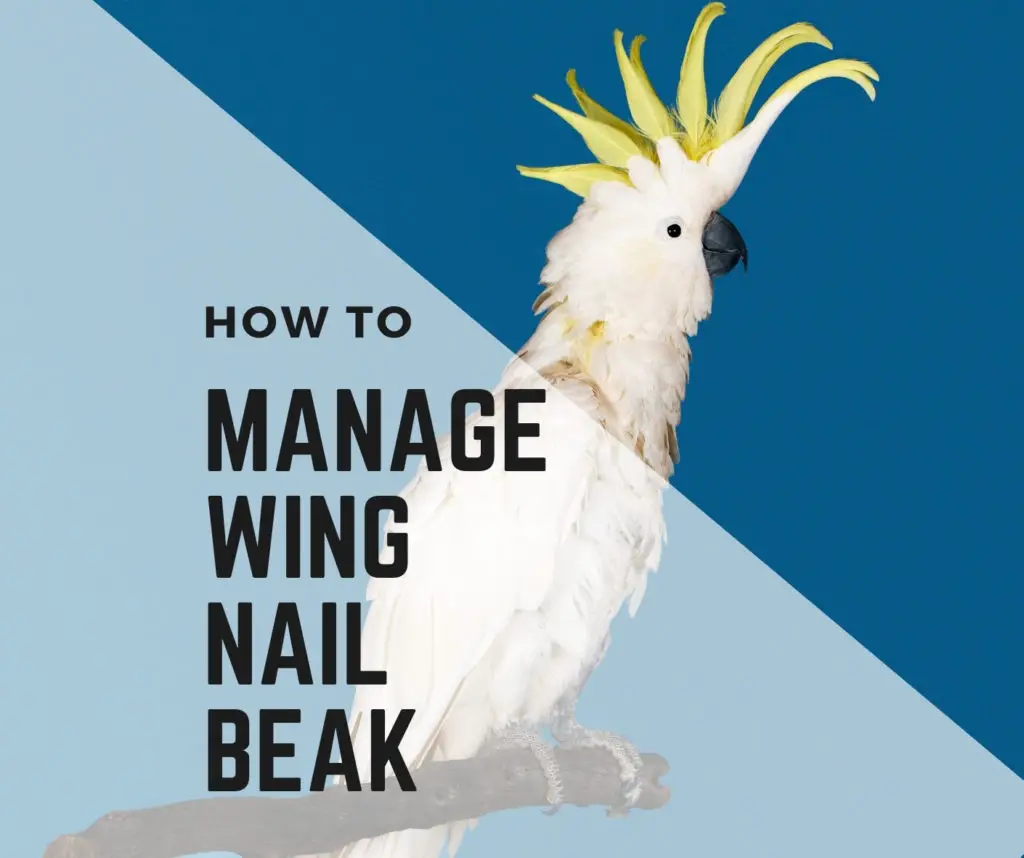What I am going to discuss today is so important yet so frequently misunderstood.
A large number of my emergency calls concern a bloody wing, tail, chest, or beak Accidents will happen and with some understanding of the cause and treatment can be easily managed.
But the majority of the traumas could have been prevented.
Since it is so important, I would like to discuss wings and wing trimming first. Why trim wings in the first place?
Trimming Wings
It may seem beautiful to allow a free flight of birds in the house, but it is actually inviting a disaster.
Your bird will find the most toxic item, most valuable piece of woodwork, a seemingly but not open sliding glass door, or fastest ceiling fan.
Free flight makes it nearly impossible to keep up with your bird’s activities in the house.
What you want to maintain and protect is the bird’s ability to flutter from point to point, or to safely and smoothly parachute to the ground.
From the tip of the wing inwards to the wrist (or first wing joint), there are ten long flight feathers and the only feathers that should ever be cut.
When you trim a baby bird’s feathers for the first time, it is not necessary to cut more than five or six feathers on each side.
As the bird becomes stronger, you can always trim once more.
But once you have cut off the full ten primary flight feathers, that bird will fall like a ton of bricks and hurt itself; and there will be no solution until it molts its feathers for the first time.
Birds Haircut ( Cosmetic Trim)
Think of it as a haircut, in that you can always cut more if necessary.
Some people like to leave the outermost two feathers uncut so that they fold over back and look nicer. This is called a cosmetic trim.
One of the most common emergency calls involves a bleeding wing or tail. It is a growing feather that has cracked or even broken off.
A mature feather shaft is clean and empty, like a writing quill, or a feather you might find on the ground.
When it is in the growing stage, however, the quill or shaft is black blue/black or bright pink.
Avoid Bleeding
It contains numerous blood vessels, and nerves. If one of these feathers should be broken or chewed, there will be an impressive amount of blood (it always seems like there is more than there really is).
The typical scenario is one of a bird that hurts but now sees its owner getting excited and scared, trying to grab him with a towel perhaps, but generally “freaking out”.
This inevitably gets the bird all excited, which further raises his blood pressure, causes him to climb around the cage more, and/or flap his wings.
It is no surprise that the bleeding will not stop.
The broken feather can be grabbed lightly, for 10-15 minutes until the blood has a chance to clot.
But far more effective in these cases is to allow the bird to calm down so that its blood pressure drops and the blood has a chance to clot.
This is most easily accomplished by putting the bird in absolute darkness, for example in a bathroom with no windows.
Leave him there for 20 minutes. Leave him alone. It is not easy to do but have faith.
Birds would be extinct by now if broken blood feathers were guaranteed not to bleed so much. The key here is to defuse and calm the situation.
Broken Feathers
The next day, if the feather is badly broken, the base can be grabbed with a surgical instrument and slid out, but it can be tricky and painful and should best be done with professional help.
Pulling out only slightly cracked and almost mature feathers will only start the process over from scratch and you will have another two weeks of danger.
Even with the perfect wing trims, birds still fly into windows or fall over the floor and usually crack the beak tips.
once the beak has a crack, you may notice that your bird won’t eat, climb, pick up things, and generally behaves sick.
Beak Management
A cracked beak is like a broken tooth and it hurt a lot.
If the beak with a deeper crack, the bird may drop blood from the beak tip.
In many ways, this is another case of high blood pressure worsening the bleeding.
But a deeply split beak can be a cause of bird death due to bleeding.
It is not the pain, but the continuous bleeding that may concern you.
The beak’s end can be plugged or corked using a mass softened soap.
Scrape the underside of the soap bar from the bathroom.
This technique can be applied as first aid for birds bleeding nails.
Summary
Lastly, I want to say something about African Grey parrots and split chests.
Flying down to the ground quickly is an instinctive defense mechanism to hide in the undergrowth against flying predators.
When the wings are cut too much and/or the floor is harder than the jungle undergrowth,
the skin is split over the ridge of breastbone known as “the keel”. It can be minor or it can be a terrible split.
Either way, it will not heal over on its own and must be sewn closed surgically.
If the wings are overcut, it is more likely that the chest is going to first be split open again the next time he takes a fall.
Sometimes the most important aid in an emergency is knowledge about what is happening.
I hope this can give some peace of mind in some future inevitable situations.

Hi, There and Welcome to BirdsNews.com, is here to help you learn and care about pet birds. and this blog is a journal of everything I’ve learned.

